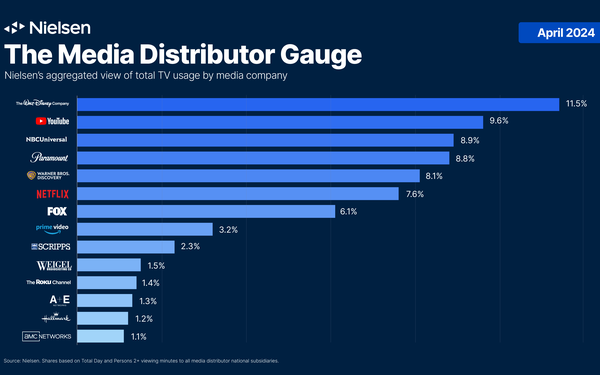Commentary
Does Nielsen's 'Distributor Gauge' Tell A Good Story For Legacy Media?
- by Wayne Friedman , Staff Writer, May 17, 2024

Nielsen's effort to show a complete picture with its new “Media Distributor Gauge” totals all viewing from all platforms -- streaming, linear and otherwise for media companies. But some elements seem to be out of the frame.
Walt Disney -- which includes its ABC Television Network ESP, as well as streaming platforms Disney+, Hulu, and ESPN+ -- comes out on top when totaling up all viewing minutes over the last six months, an 11.5% share.
YouTube comes in second (9.6%), followed by NBCUniversal (8.9%), Paramount (8.8%) and Warner Bros. Discovery (8.1%).
But you may wonder where Netflix is. The presumed premium streaming video leader is right behind the big four legacy media companies and YouTube -- in fifth place with a 7.6% share.
In a way, this measure takes apart Nielsen’s other new total TV measurement “The Gauge,” which analyzes TV via its different significant “channels” -- streaming, broadcast and cable.
advertisement
advertisement
The question, course, is whether the big legacy media companies can maintain their total TV usage status in terms of monetization -- advertising and/or subscription fees from their broad TV-video businesses.
We all know the direction where linear TV is going. The question is whether it can put all that legacy TV usage and business into their premium platforms -- perhaps with a boost from higher-priced advanced advertising price points linked to its media plans.
This all makes sense when it comes to the upcoming TV upfront advertising market. And in particular it gave Rita Ferro, president of global advertising at Walt Disney, something to crow about in the early minutes of Disney’s upfront presentation this week.
And there is good news: legacy media companies including Disney, NBCU, Paramount Global, Warner Bros. Discovery already sell their advertising this way in massive inventory and placement packaging on linear, streaming, and perhaps other digital platforms.
But are we missing some granular information for brands? That's important for those with a strong interest in legacy over-the-air television, especially local TV stations.
Steve Lanzano, CEO and president of local TV station-focused advertising trade group TVB, said this week: “The [Media Distributors] Gauge reports combine all video platforms in one analysis -- without separating ad-supported viewing from non-ad supported viewing -- which misleads marketers into thinking their commercials can reach significantly more streaming viewers than is possible or the reality.”
Yes, it’s an overview. And perhaps not a basis for a media plan for specific brands.
And just to be fair, we don’t have a full picture of Amazon Prime Video, for example -- which can be sold with Fire TV Channels, FreeVee (the long-form FAST Network), Amazon devices (Echo) or as part of Amazon's broader retail media network.
It’s not ideal.
And where the rubber really meets the road is when Nielsen “Media Distributors Gauge” offers up month-to-month changes in how big media is doing with that transition -- or not.




Wayne, even though "legacy TV"---broadcast and cable----is slowly declining in total viewing time while streaming is slowly inching upward, the Nielsen numbers, when analyzed as they might apply to national advertising still tell a very good linear TV story for advertisers---especially those with mass usage products and services. As it happens,we are slicing and dicing the stats and filling in missing breakdowns with reasonable estimates, including the proportion of viewing time that is ad-supported, the proportion that is devoted to national content and the amount of ad clutter per hour on each service. When you do that and confine yourself only to ad viewing time that a national advertiser might consider, streaming generates about a fifth of the available GRPs, not 38% as some believe based on the overal streaming share of viewing. This exclusive report will be avaiable to our MDI Direct subscribers shortly.
Of course there are variations by age groups and the streaming percentage rises considerably for advertisers who are only targeting 18-34s---except very few advertisers derive 100% of their sales from this group and zero from adults aged 35+. So the best mix for now, in most cases, is probably linear TV first, with an overlay of streaming, not the other way around.
With this in mind, our subscribers will, no doubt, find our breakdown of the percentage of GRPs attained by the five top "legacy TV" programmers combined via linear TV and streaming of particular interest. Stay tuned, folks.
Using an average quarter hour net reach number across any and all media is the one KPI to rule them all if we want to be completely honest and comparing apples to apples. It's really that simple.